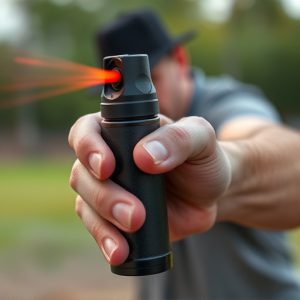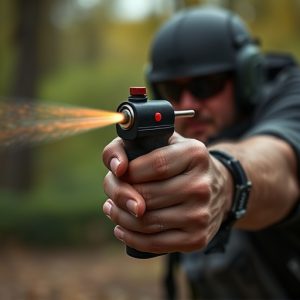Pepper Spray Safety: Decontamination Steps and Non-Lethal Deterrents for Home
Using pepper spray for self-defense requires immediate decontamination of your home to ensure safety…….
Using pepper spray for self-defense requires immediate decontamination of your home to ensure safety and cleanliness. Steps include ventilating the area, removing contaminated items, wiping down surfaces, washing affected clothing in hot water, and disinfecting high-touch surfaces. Advanced alternatives like noise deterrents and smart home technology further enhance protection, complementing traditional measures and providing peace of mind.
“Personal security is a top priority in today’s world, and non-lethal deterrent devices offer a powerful yet responsible approach. This article explores one such tool, pepper spray, its effectiveness in personal defense, and crucial decontamination steps after use. We’ll guide you through understanding the basics of pepper spray and its role in keeping you safe. Additionally, we provide an extensive step-by-step process for decontaminating your home following pepper spray deployment, ensuring a thorough clean. Beyond pepper spray, we also uncover diverse non-lethal deterrent options to enhance your overall home safety.”
- Understanding Pepper Spray: The Basics and Its Role in Personal Security
- Step-by-Step Guide: Decontaminating Your Home After Pepper Spray Use
- Enhancing Safety at Home: Beyond Pepper Spray – Additional Non-Lethal Deterrent Options
Understanding Pepper Spray: The Basics and Its Role in Personal Security
Pepper spray, a non-lethal deterrent, has become an essential personal security device for many individuals seeking to protect themselves in various situations. At its core, pepper spray is a type of irritant that causes temporary yet severe discomfort when sprayed into the eyes and respiratory system of a target. This disruption enables the user to escape or defend themselves against potential threats.
When it comes to pepper spray decontamination steps at home, understanding the basics is crucial. After using pepper spray, victims should immediately seek fresh air by exiting the area and moving to a well-ventilated space. Removing contaminated clothing and washing affected areas with soap and water can help alleviate symptoms. It’s important to have a plan in place and ensure that all family members know what to do in case of exposure to ensure swift and effective decontamination.
Step-by-Step Guide: Decontaminating Your Home After Pepper Spray Use
After using pepper spray for self-defense, decontaminating your home is crucial to ensure safety and maintain a clean environment. Here’s a step-by-step guide to help you through the process:
1. Ventilate the Area: Open windows and doors to allow fresh air circulation. This helps dissipate the pepper spray residue, making it safer to enter and clean affected areas. Keep ventilating until the air feels fresh and no longer smells of pepper spray.
2. Remove Contaminated Items: Take out any clothing, bedding, or other items that were in direct contact with pepper spray. Place them in sealed plastic bags for thorough washing later. Avoid touching these items directly to prevent further exposure.
3. Wipe Down Surfaces: Use a damp cloth or sponge to wipe down all surfaces, including furniture, countertops, and walls. Make sure to dispose of the cleaning material used in a sealed bag afterward. Focus on areas where pepper spray may have settled, such as doorknobs, light switches, and window handles.
4. Clean Hard Surfaces: For floors, tiles, or other hard surfaces, use a mixture of warm water and mild detergent. Scrub affected areas thoroughly with a sponge or mop. Rinse well and dry completely to prevent any residue from attracting bugs or causing slip hazards.
5. Laundry: Wash all clothing, bed linens, and towels that may have been exposed to pepper spray separately in hot water to kill any remaining irritants. Use detergent as usual and avoid using fabric softener until the laundry is thoroughly dried.
6. Disinfect High-Touch Surfaces: After everything else is cleaned and dry, disinfect high-touch surfaces again with a suitable disinfectant solution. This includes doorknobs, light switches, remote controls, and any other commonly used items to ensure a thorough decontamination.
Enhancing Safety at Home: Beyond Pepper Spray – Additional Non-Lethal Deterrent Options
While pepper spray remains a popular non-lethal deterrent, there are additional options to enhance your home’s security. Beyond the decontamination steps involved in using pepper spray, consider investing in noise deterrents like personal alarms or stun guns, which can startle intruders and alert neighbors. These devices often come with built-in LED flashlights, adding another layer of protection during nighttime incidents.
Additionally, smart home technology offers innovative solutions. Motion sensors and security cameras can detect unusual activity, sending alerts to your smartphone. Some systems even allow for remote access, enabling you to monitor your property from afar. These advanced measures complement traditional deterrents like locks and barriers, creating a comprehensive safety net for your household.
In conclusion, while pepper spray serves as a valuable non-lethal deterrent for personal security, proper decontamination steps at home are essential after its use. By understanding how to safely decontaminate your living space, you can ensure the well-being of yourself and your loved ones. Additionally, exploring other non-lethal deterrent options enhances overall home safety measures. Remember, staying informed about these practical strategies empowers individuals to protect themselves effectively in various situations.


